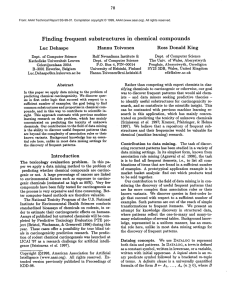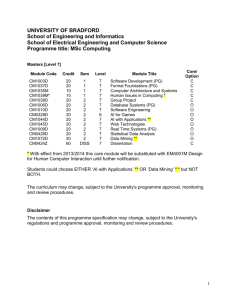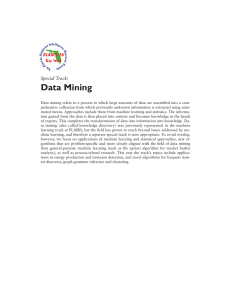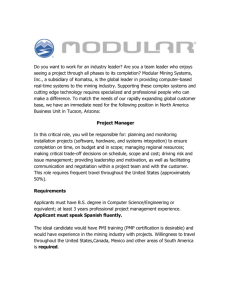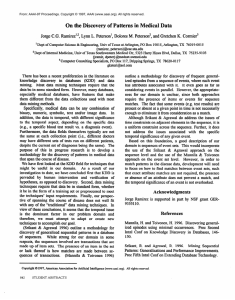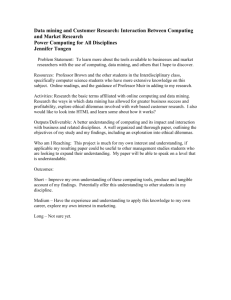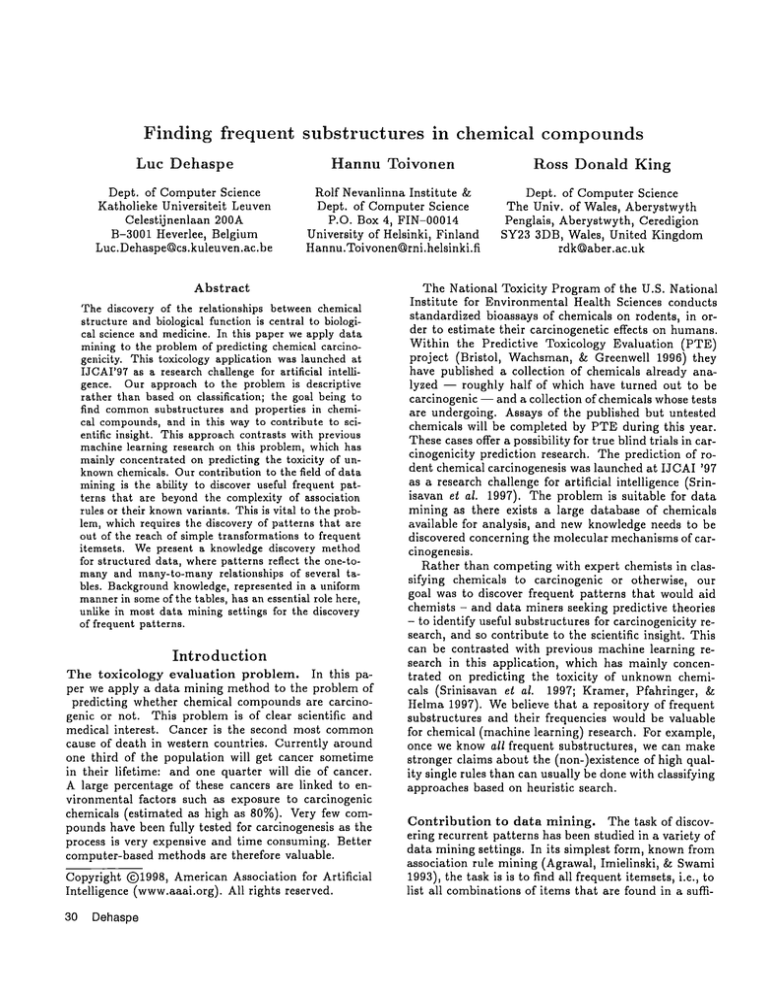
Finding frequent
Luc
Dehaspe
Dept. of Computer Science
Katholieke Universiteit Leuven
Celestijnenlaan 200A
B-3001 Heverlee, Belgium
Luc.Dehaspe@cs.kuleuven.ac.be
substructures
Hannu
Toivonen
Rolf Nevanlinna Institute &
Dept. of Computer Science
P.O. Box 4, FIN-00014
University of Helsinki, Finland
Hannu.Toivonen@rni.helsinki.fi
Abstract
The discovery of the relationships between chemical
structure and biological function is central to biological science and medicine. In this paper we apply data
mining to the problemof predicting chemical carcinogenicity. This toxicology application was launched at
IJCAI’97as a research challengefor artificial intelligence. Our approach to the problem is descriptive
rather than based on classification; the goal being to
find commonsubstructures and properties in chemical compounds,and in this way to contribute to scientific insight. This approachcontrasts with previous
machinelearning research on this problem, which has
mainly concentrated on predicting the toxicity of unknownchemicals. Our contribution to the field of data
miningis the ability to discover useful frequent patterns that are beyond the complexity of association
rules or their knownvariants. This is vital to the problem, whichrequires the discovery of patterns that are
out of the reach of simple transformations to frequent
itemsets. Wepresent a knowledgediscovery method
for structured data, wherepatterns reflect the one-tomanyand many-to-manyrelationships of several tables. Backgroundknowledge,represented in a uniform
mannerin someof the tables, has an essential role here,
unlike in most data miningsettings for the discovery
of frequent patterns.
Introduction
The toxicology evaluation
problem. In this paper we apply a data mining method to the problem of
predicting whether chemical compounds are carcinogenic or not. This problem is of clear scientific and
medical interest.
Cancer is the second most common
cause of death in western countries. Currently around
one third of the population will get cancer sometime
in their lifetime: and one quarter will die of cancer.
A large percentage of these cancers are linked to environmental factors such as exposure to carcinogenic
chemicals (estimated as high as 80%). Very few compounds have been fully tested for carcinogenesis as the
process is very expensive and time consuming. Better
computer-based methods are therefore valuable.
Copyright Q1998, American Association for Artificial
Intelligence (www.aaai.org). All rights reserved.
30 Dehaspe
in chemical
compounds
Ross
Donald
King
Dept. of Computer Science
The Univ. of Wales, Aberystwyth
Penglais, Aberystwyth, Ceredigion
SY23 3DB, Wales, United Kingdom
rdk@aber.ac.uk
The National Toxicity Program of the U.S. National
Institute for Environmental Health Sciences conducts
standardized bioassays of chemicals on rodents, in order to estimate their carcinogenetic effects on humans.
Within the Predictive Toxicology Evaluation (PTE)
project (Bristol, Wachsman, & Greenwell 1996) they
have published a collection of chemicals already analyzed -- roughly half of which have turned out to be
carcinogenic -- and a collection of chemicals whosetests
are undergoing. Assays of the published but untested
chemicals will be completed by PTEduring this year.
Thesecases offer a possibility for true blind trials in carcinogenicity prediction research. The prediction of rodent chemical carcinogenesis was launched at IJCAI ’97
as a research challenge for artificial intelligence (Srinisavan et al. 1997). The problem is suitable for data
mining as there exists a large database of chemicals
available for analysis, and new knowledge needs to be
discovered concerning the molecular mechanismsof carcinogenesis.
Rather than competing with expert chemists in classifying chemicals to carcinogenic or otherwise, our
goal was to discover frequent patterns that would aid
chemists - and data miners seeking predictive theories
- to identify useful substructures for carcinogenicity research, and so contribute to the scientific insight. This
can be contrasted with previous machine learning research in this application, which has mainly concentrated on predicting the toxicity of unknownchemicals (Srinisavan et al. 1997; Kramer, Pfahringer, &
Helma 1997). Webelieve that a repository of frequent
substructures and their frequencies would be valuable
for chemical (machine learning) research. For example,
once we know all frequent substructures, we can make
stronger claims about the (non-)existence of high quality single rules than can usually be done with classifying
approaches based on heuristic search.
Contribution to data mining. The task of discovering recurrent patterns has been studied in a variety of
data mining settings. In its simplest form, knownfrom
association rule mining (Agrawal, Imielinski, & Swami
1993), the task is is to find all frequent itemsets, i.e., to
list all combinationsof items that are found in a suffi-
cient number of examples. A prototypical application
example is in market basket analysis: find out which
products tend to be sold together.
Our contribution to the field of data mining is in
considering the discovery of useful frequent patterns
that are far more complex than association rules or
their knownvariants. Wediscover queries in first-order
logic that succeed with respect to a sufficient number of examples. Such patterns are out of the reach
of simple transformations to frequent itemsets. We
present an attempt for knowledge discovery in structured data, where patterns reflect the one-to-many and
many-to-many relationships of several tables. Background knowledge, represented in a uniform manner,
has an essential role here, unlike in most data mining
settings for the discovery of frequent patterns.
Datalogconcepts.
We use DATALOG(see,e.g.,(Ullman 1988))to represent
bothdataand patterns.
DATALOG, a termis defined
as a constant
symbol,
writtenin lowercase,
ora variable,
written
withinitial
uppercase.
A lo#icalatomis an m-arypredicate
symbol
followed
by a bracketed
m-tupleof terms.A definite
clauseis a universally
quantified
formula
of theform
B ~-- Ai, ...I An (n > 0), whereB and the Ai are
logicalatoms.Thisformulacan be readas "B if Ai
and...and An’.If n = 0, a definite
clauseis also
called
a fact.A (deductive)
DATALOG
database
is a set
of definite
clauses.
A formula
4---Ai,...,A,~withouta conclusion
partis called
a denial.
Sucha formula
canalsobe viewedas a (PrtOLOG)
{/uery?- Ai,...,
An:(theresolution
basedderivation
of)theanswer
a givenquerywithvariables
(Xi,...,
X,~)bindsthese
variables
toterms
(al,¯ ¯.,a~),suchthatthequery
succeedsif eachXi is replaced
by ai.Thisbinding
is denoted by (Xl/al,...,X~/a~). Due to the nondeterministic nature of the computation of answers, a single
query Q may result in many bindings. Wewill refer by
answerset(Q,, D) to the set of all bindings obtained by
submitting query Q to a DATALOG
database D.
Data and background
knowledge.
The DATALOGdatabase for the carcinogenesis
problem was
taken from http://www.comlab.oz, ac.uk/oucl/#roups/
machlearn/PTE/. The set we have used contains 337
compounds, 182 (54%) of which have been classified
carcinogenic and the remaining 155 (46%) otherwise.
Each compound is basically described as a set of
atoms and their bond connectivities,
as proposed
in (King et al. 1996). The atoms of a compound are represented
as DATALOG
facts such as
atom(d1,dl_~5,h,1,0.327)
stating that compound dl
contains atom d1_~5 of element h and type 1 with partial charge 0.327. For convenience, we have defined
additional view predicates atomel, atomty, and atomch;
e.g., atomel(d1,dl.25,h). Bonds between atoms are defined with facts such as bond(all, d1-$4, d1_25,1), meaning that in compounddl there is a bond between atoms
dl_Z4 and d1_25, and the bond is of type 1. There are
roughly18500of these atom/bondfacts to represent
the basic structure of the compounds.
In addition, background knowledge contains around
7000 facts and some short DATALOG
programs to define mutagenic compounds, genotoxicity properties of
compounds, generic structural groups such as alcohols,
connections between such chemical groups, tests to verify whether an atom is part of a chemical group, and a
family of structural alerts called Ashby alerts (Ashby
Tennant 1991).
Representation
of substructures.
The target patterns or substructures
are expressed as DATALOG
queries. For instance, ?- atomel(C,A,c), methyl(C,S)l
oecurs_in(A,S) is a pattern representing a carbon
atom A that occurs in a methyl structure S within compound C.
Related work. Related problems in structure discovery in molecular biology have been considered, e.g., in
(Wang et al. 1997; Kramer, Pfahringer, & Helms 1997;
King et al. 1996; King & Srinivasan 1996). Substructure discovery and the utilization of background knowledge have been discussed in (Djoko, Cook, & Holder
1995). Discovery of logical patterns, similar to DATALOG queries, has been considered in (De Raedt & Dehaspe 1997) and in the context of metaqueries (Shen
et al. 1996); they also emphasize the use of language
bias for the specification of the search space. Closely
related data mining problems have recently arisen also
in schema discovery in semi-structured data (Wang
Liu 1997).
The substructure discovery problem we look at has a
complexity somewherebetween frequent itemset discovery and a full-scale inductive logic programming(ILP;
see, e.g., (Lavra~ & D~.eroski 1994)) approach. In data
mining, related problems in the area of discovering frequent patterns include association rules (Agrawal et
al. 1996), episodes in sequences (Mannila, Toivonen,
& Verkamo 1997), and sequential patterns (Agrawai
Srikant 1995), a family of problems discussed in more
general in (Mannila & Toivonen 1997).
Within ILP, a closely related problem is the discovery of queries in first order logic that succeed with respect to a sufficient number of examples (Dehaspe
De Raedt 1997). In (Dehaspe & Toivonen 1998)
discuss the relationship of ILP to frequent pattern discovery, and relate data mining problems to ILP. The
logical setting for substructure discovery is based on
the learning from interpretations paradigm introduced
in (De Raedt & D~eroski 1994).
Frequent
substructure
discovery
Discovery task. Intuitively,
the problem we consider
is the following: given the above data on chemical compounds and their structures and properties, find recurrent compoundsubstructures and properties. Since the
KDD-98 31
properties are also a result of the structure of a compound, for the rest of the paper we just talk collectively
about (sub)structure discovery.
This problem is an instance of the generic problem
of finding all potentially interesting sentences (Mannila
& Toivonen 1997). Given a database r, a class £ of
sentences (patterns), and a selection predicate q which
is used for evaluating whether a sentence Q E/3 defines
a potentially interesting pattern in r. The task is to
find the theory of r with respect to £ and q, i.e., the
set Th(£, r, q) = {Q E £ [ q(r, Q) is true). In (Dehaspe
& Toivonen 1998)~ this framework has been used to
formulate the task of frequent query discovery in DATALOG. Wenow define frequent substructure
discovery
as a special case of frequent query discovery.
Definition 1 (Frequent substructure
discovery)
Assume
¯ r is a DATALOG
database of chemical compounds,
their structures and properties, as described above,
¯ £ is a set of substructures ezpressed as DATALOG
queries ?- A1, ..., An, where each logical atom Ai
concerns some structural property of the compounds,
as described above,
¯ q(r, Q) is true if and only if the frequency of query
Q E 12 with respect to r is at least equal to the frequency threshold specified by the user.
The task is to find the set Th(£, r,q) of all frequent
substructures.
Wenext define what frequency exactly means in this
setting.
Definition 2 (Substructure
frequency) Given
r and Q G £ as above, a relation keypred(C), where
keypred is a predicate name not used in Q or r, and C
is the key variable used in Q to refer to the compound
namej the (absolute) frequency of query Q w.r.t, r
[answerset(?- keypred(C), r U {keypred(C) +-- Q})[,
i.e., the numberof bindings of the C variable with which
the query Q is true in r, i.e., the numberof compounds
in which substructure Q occurs.
Frequent probabillstle
rules. Once frequent substructures and their frequencies are discovered, probabilistic rules can be produced, muchlike in the case
of association rules. In terms of the DATALOG
concepts
introduced above, a probabilistic rule R is an expression
of the form A1,...,A~ ~ A~+I,...,An,
where At are
atoms. This formula should be read as "if query ?A1,...,AI:
succeeds then query ?- A1,...,An succeeds
also". The confidence of rule R can be computed as
the ratio of the frequencies of queries ?- A1,... ,Aa and
?- A1,...,Ak. The frequency (or support) of rule R is
the frequency of query ?- A1,...,An.
The patterns searched for are significantly different
from frequent itemsets or association rules, and we cannot see any useful or meaningful way of transforming
32 Dehaspe
the problem into a search for association rules. As an
example, consider the discovery of a pattern such as
if(in a given compound) a carbon atom has a bond
with an atom with partial charge tess than -0.2
then (the compoundis) carcinogenic.
As a (propositional) association rule, it seems impossible to break the condition part to a conjunction of
several items. If "carbon atom" is one item and "atom
with partial charge less than -0.2" another item, how
can we represent the fact that they have a bond? The
straightforward way is to consider the condition of the
rule as just one item ’% carbon atom that has a bond
with an atom with partial charge less than -0.2". Such
an approach with association rules leads to two serious
problems.
¯ The number of different items explodes, as each possible combination of properties that can be associated
with an atom must be considered as a separate item.
Since several atoms can be related, as in the example
above, the numberof possible items explodes further.
¯ The search (e.g., with APRIOrtI)is inefficient as the
search space is flattened and the structural information is lost. The generalization hierarchy between the
derived items could in principle be treated as an item
hierarchy, but the proposed methods (Han & Fu 1995;
Holsheimer et al. 1995; Srikant & Agrawal 1995) are
not feasible for complexcases like this.
As a probabilistic
rule,
be expressed in a natural
atomch(C,A$,X), -0.~ > X,
cinogenic. In the following
a method for searching such
Substructure
in turn, the pattern can
way as atomel(C, Al, c),
bond(C, A1,A2, Y) ~
section we describe WARMR,
frequent patterns.
discovery
with WARMR
Wenow briefly describe the WARMP~
algorithm used in
the experiment. More details can be found in (Dehaspe
& De Raedt 1997; Dehaspe & Toivonen 1998). WAR.MR
is the first general purpose ILP system to employ the
efficient levelwise method knownfrom the APRIORIalgorithm (Agrawat et al. 1996). In (Dehaspe & Toivonen 1998) we show how WArtMRcan be tuned to simulate APRIORIand some other well-known algorithms
for frequent pattern discovery. A stand-alone version of
WARMR
is freely available for academic purposes upon
request.
Language bias. WAR.MR
is, in principle, capable of
discovering arbitrary frequent DATALOG
queries from
a given database. In practice, however, the application domain and problem setting constrain the set of
meaningful and useful patterns. In WARMR,
the set of
allowed patterns is specified with a declarative language
bias. This well-known ILP mechanism is valuable for
data mining systems: the search space is madeexplicit,
and modifying it is easy.
The language bias is specified using expressions of
the form rmode(n : (Aa,...,An)),
where the Ai
conjuncted logical atoms. The rmode declarations indicate which logical atoms can be included in a query, the
maximal number of times (n > 0) they can be included,
and the modesand types of the variables in the logical
atoms. A variable V in input mode, denoted with +V,
has to occur somewhereto the left in the query. Typing of variables can be used to constrain the occurrence
of input variables, such that for instance atomty(C,S,1)
will not be added to ?- atomel(C,A,c), methyl(G,S),
but atoraty(C,A,1) or occurs_in(A,S) will. This format
for the definition of the language of pattern £ was originally proposed for PROGOL
(Muggleton 1995) and later
adapted to TILDE(Blocked & De Raedt 1998).
Levelwlse search. The levelwise algorithm (Mannila
& Toivonen 1997) is based on a breadth-first
search
in the lattice spanned by a specialization relation_’~
between patterns, where plY_p2 denotes pattern "pl is
more general than pattern p2", or "p2 is more specific
than pattern pl". The specialisation relation used in
WARMR
is 0-subsumption, a strictly stronger variant of
the subset relation: pl 0-subsumes a p2 if and only if
there exists a (possibly empty) binding of the variables
of pl, such that every logical atom of the resulting query
occurs in p2.
The levelwise method looks at a level of the lattice
at a time, starting from the most general patterns. The
method iterates between candidate generation and candidate evaluation phases: in candidate generation, the
lattice structure is used for pruning non-frequent patterns from the next level; in the candidate evaluation
phase, frequencies of candidates are computed with respect to the database. Pruning is based on monotonicity of _ with respect to frequency: if a pattern is not
frequent then none of its specialisations are frequent. So
while generating candidates for the next level, all the
patterns that are specialisations of infrequent patterns
can be pruned.
The levelwise approach has two crucial useful properties (Mannila & Toivonen 1997). First, the database
scanned at most k + 1 times, where/~ is the maximum
level (size) of a frequent pattern. All candidates of
level are tested in single database pass. This is an important factor when mining large databases. Second,
the time complexity is linear in the size of the result
times the number of examples, assuming matching patterns against the data is fast.
Candidate
generation
in WARMR.To generate
candidates, WARMR
employs a classical specialisation operator under 0-subsumption (Lavra~ & D~,eroski
1994). A specialisation operator p maps queries E £:
onto sets of queries E 2£, such that for any Query1and
V Query2 E p(Queryl), Queryl 0-subsumes Query2.
The operator used in WARMR
essentially adds conjunctions to the query as allowed by the language bias spec-
ifications.
The language bias, in particular mode declarations
and the fact that conjunctions of several logical atoms
can be added in a single refinement step, complicates
pruning significantly.
Wecan no longer require that
all subsets of a candidate are frequent, cf. for instance
APRIORI, as some of the subsets might simply not be
in ~:. Instead, WARMR
requires candidates not to 0subsume any infrequent query.
Candidate
evaluation
and memory management
in WARMR.
In the candidate evaluation phase the frequencies of a set of queries are computed in a single
database pass. Therefore, a straightforward execution
of Definition 2 (frequency of a single query) is not practical, as it would require one pass per candidate. The
WARMR
algorithm rather considers one compound C
at a time and for each candidate Qi runs the query
?- keypred(C) in database r°U r sG (9 {keypred(C) ~-Qi}, where r ° c r only contains clauses about compound C and r ~ C_ r is a fixed portion of background
knowledgewhich contains clauses relevant for all compounds. If query Qi succeeds, an associated counter qi
is incremented.
Here we take advantage of the fact that database r
of n compounds C1,..., Cn, and background knowledge
BG can be partitioned into n + 1 databases r °t U... U
r°~U r Ba. For very large databases of compounds it
is essential that r °~ is typically very small comparedto
r, and can be loaded in main memoryeven if r cannot. This has the crucial advantage that evaluation of
candidates Qi can be done (relatively) efficiently with
respect to a single compoundat a time.
Experiments
Werandomly split the set of 337 compounds into 2/3
for the discovery of frequent substructures, and 1/3 for
the validation of derived probabilistic rules about carcinogenicity.
Frequent substructures.
In order to investigate the
usefulness of different types of information in the biochemical database, WARMR’s
language bias was varied
to produce three sets of frequent patterns.
¯ Ezperimeng 1: only atom element, atom type, and
bond information. At level 6, WA~tMR
generates substructure ?- a~omel(C, Al, c), bond(C, AI,A2,BT),
atomel(C, A2,c), atomty(C,A~,lO), a~omel(C, A3,h),
bond(C,A$,A3,BT), i.e., "a carbon atom bound to a
carbon atom of type 10 bound to a hydrogen atom,
where the two bonds are of the same bond type". In
the training set, this highly frequent substructure is
encountered in 128 compounds (57%).
¯ Ezperiment 2: everything except the atom/bond information. An example of a substructure discovered at level 4 is ?- siz._ring(C,8l), alcohol(C, S2),
ashby_aler~(C,dil O, SS), connected(S1,SS) (frequency:
KDD-98 33
m(F = 10%)]E2(F = 4%)E3(F =
NOC NOFS
L
6
1
6
123
34
2
3
214
137
813
672
4
3725
5
4133
23961
6 25434
Total 29993 28535
NOC
58
1093
3381
15411
NOFS
41
413
2631
13963
NOC NOFS
85
49
501
1466
2184
3219
6219
7190
15577 14435
19934 17048 27537 23388
Table 1: Results of three runs with WARMR
on carcinogenicity analysis. Legend: E = experiment, F =
frequency threshold, L = level, NOC= number of candidates, NOFS= number of frequent substructures.
11 compounds(5 %)), i.e., "an alcohol and a six ring
connected to a structure with Ashby alert dil0".
¯ E~periment 3: the full database, except the Ashby
alerts. At level 5, VVARMR
produces substructure
?- 8i~_ring(C,S), atomel(C, A1,h), ato,~el(C, A2,c),
bond(C, A1,AZ, X), occurs_in(A2,S) (frequency: 157
compounds (70%), i.e., ’% hydrogen atom bound
a carbon atom in a six ring".
The number of candidates and frequent patterns produced during these experiments is tabulated in Table 1.
Notice that, overall, there are few infrequent candidates, and the numberof candidates steadily increases.
As a consequence, the exploration of deeper levels is
problematic. The empty cells in the table indicate at
which level the experiments were interrupted.
Probabillstic rules. As described above, our repository of frequent substructures can be exploited directly, i.e. without going back to the database, to
produce probabilistic rules about carcinogenicity. For
instance, we can combine ?- cytogen_ca(C,n), 8ulfide(C,S) (frequency: 7%) and ?- non_carcinogenic(C),
cytogen_ca(C,n), sulfide(C,S) (frequency: 6%) to generate the probabilistic rule
cytogen.ca(C,n), sulfide(C,S) ::~ non_carcinogenic
(frequency: 6%; confidence: 86%).
To rank these rules we have applied a binomial test that verifies how unusual the confidence
of rule substructure(C) ~ (non_)carcinogenic(C) is,
i.e. how much it deviates from the confidence of
true =~ (non_)carcinogenic(C). All rules with significance below 3 * ¢r were discarded, with cr an estimation of the standard deviation. For instance, the significance level of the above rule is 3.16 * ~. The 215 rules
that passed this test were further annotated with their
significance level on the 1/3 validation set, and finally
combined with humandomain expertise. The list below
summarizes the main findings.
¯ In experiment 1, only using atom-bond information,
no substructure described with less than 7 logical
34 Dehaspe
atoms is found to be related to carcinogenicity. This
places a lower limit on the complexity of rules that
are based exclusively on chemical structure.
¯ For experiments 2 and 3, validation on an independent test set showedthat the rules identified as interesting in the training set were clearly useful in prediction. The estimated accuracies of the rules from the
training data were optimistically biased, as expected.
¯ The rules found in experiments 2 and 3 are dominated by biological tests for carcinogenicity. It is very
interesting that these tests appear broadly independent of each other, so that if a chemical is identified
as a possible carcinogenby several of these tests, it is
possible to predict with high probability that it is a
carcinogen - unfortunately, such compoundsare rare.
¯ Inspection of the rules from experiment 2 revealed
that the Ashby alerts were not used by any rules.
Webelieve this reflects the difficulty humans and
machine have in discovering general chemical substructures associated with carcinogenicity - however,
it is possible that the intuitive alerts used by Ashby
were incorrectly interpreted and encoded in PROLOG
by (King & Srinivasan 1996).
¯ Inspection of the rules from experiment 3 revealed no
interesting substantial chemical substructures (atoms
connected by bonds) in the rules found.
¯ Twoparticularly interesting rules that combine biological tests with chemical attributes were found.
It is difficult to comparethese with directly existing knowledge, because most work on identifying
structural alerts has been based on alerts for carcinogenicity, while both rules identify alerts for noncarcinogenicity. It is reasonable to search for noncarcinogenicity alerts as there can be specific chemical mechanismsfor this, e.g. cytochromes specifically neutralise harmful chemicals. The rule ?- cytogen_ca(C,n), ring(sulfide, A,B) for identifying noncarcinogenic compounds is interesting.
The combination of conditions in the rule seems to be crucial:
the cytogen and sulfide tests in isolation seem to do
worse. Within rule ?- atomch(C,A,X), X<_ -0.215,
salmonella(C,n) the addition of the chemical test
makes the biological test more accurate at the expense of less coverage. As the rule refers to charge
this rule may be connected to transport across cell
membranes.
Discussion. It is interesting and significant that no
atom-bond substructures described with less than 7
conditions were found to be related to carcinogenicity. This result is not inconsistent with the results obtained by (King & Srinivasan 1996) and (Srinivasan et
al. 1997) using PROGOL
because most of the substructures there involve partial charges, and the ones that
don’t do not meet the coverage requirements in experiment 1. The hypothesis space which PROGOL
searched
to form its theory (a single complexdisjunctive "alert")
is larger than the hypothesis space of queries searched
by WARMR. Comparing the PI~OGOLtheory on this
split it is interesting to see that the significance score
is not very good on train and test set, whereas the accuracy is good on the test set, and the significance is
good on the overall set.
Although the lack of significant atom-bond substructures found in experiment 1 is disappointing, it is perhaps not too surprising. The causation of chemical carcinogenesis is highly complex with manyseparate mechanisms involved. Therefore predicting carcinogenicity
differs from standard drug design problems, where there
is normally only a single well defined mechanisms. We
consider that it is probable that the current database is
not yet large enough to provide the necessary statistical evidence required to easily identify chemical mechanisms. Biological tests avoid this problem because they
detect multiple molecular mechanisms; e.g., the Ames
test for mutagenesis detects manydifferent ways chemicals can interact with DNAand cause mutations; biological tests also detect whether the compoundcan
cross cell membranesand not be destroyed before reaching DNA.Biological tests vary in expense, speed, and
accuracy. At the extreme cheap and fast and relatively
inaccurate end is the Amestest for mutagenicity, this
is fast and uses bacteria (so there are no ethical issues).
At the other end are long expensive trials which involve
the dissection of thousands of rodents.
The ultimate goal of our work in predictive toxicology is to produce a program that can predict carcinogenicity in humansfrom just input chemical structure.
Such a system would allow chemicals to be quickly and
cheaply tested without harm to any animals. This goal
is still far distant. Our results suggest that an intermediate goal for data mining in this predictive toxicology problem is to identify the combination of biological
tests and chemical substructures that provides the most
cost-effective tests for testing chemical carcinogenesis.
Conclusions
Wepresented a data mining problem in a biochemical
database. The goal is to discover frequent substructures of chemical compoundsin relation to their possible carcinogenicity. Rather than trying to predict the
toxicity of unknowncompounds,our purpose is to assist
chemical experts in discovering chemical mechanismsof
toxicology.
One result of our experiment is a repository of frequent substructures in a general DATALOGformat. We
believe this repository constitutes a new description of
the data that is useful for chemists and data miners
looking for predictive theories. Wehave also identified
substructures, both known and new, that could be related to carcinogenicity. On the other hand, we have
found that, within this biochemical database, short, accurate and highly significant rules apparently do not
exist.
The frequent substructures that we search for are described as DATALOG
queries. Wegave examples of such
patterns found in the carcinogenicity database, and we
argued that association rules are not a suitable representation for patterns needed in this application. Relational patterns are needed instead to describe useful
aspect of substructures and their properties.
Although we have discussed one application only in
this paper, the problems attacked are general. While association rules are a useful formalism, there are a number of problems where much more expressive frequent
patterns can be useful. In the domain of market basket
analysis, for instance, a number of properties can be
associated with products, such as the department, the
price, etc. With association rules it wouldbe difficult
to express, e.g., the pattern that if something in promotion is purchased then something else is purchased from
the same department. Or, consider telecommunication
alarm analysis and the discovery of episodes (Mannila,
Toivonen, & Verkamo 1997) and a frequent pattern of
the form
if alarm of class c from device X and Y is a device
connected to X and Y is a base station then alarm
of class d from device Y.
Such patterns cannot be discovered with a straightforward application of propositional association or episode
rule discovery methods. Specialized solutions can certainly be found for specific cases, but with a loss of
generality and flexibility.
In this paper we outlined the WARMR
method for
discovering frequent DATALOG
queries. Wewould like
to point out two useful properties of the method. First,
by changing the language bias the user can easily
search for different patterns without modifying the algorithm. Second, WARMR
can utilize background knowledge specified as tables or DATALOG
programs. In both
these respects WARMR
differs favourably from most
data mining methods for mining frequent patterns.
Acknowledgements. Luc Dehaspe is supported by
2.
ESPRIT Long Term Research Project No 20237, ILP
Hannu Toivonen is supported by the Academy of
Finland. R.D. King was partly supported by grant
BIF08765 from the BBSRC and grant GR/L262849
from the EPSRC. We are grateful to Luc De Raedt
and Heikki Mannila for discussions and comments, and
to WimVan Laer and Hendrik Blockeel for their share
in the implementation of WARMm
References
Agrawal, R., and Srikant, R. 1995. Mining sequential
patterns. In Proceedings of ~he Eleventh International
Conference on DaSa Engineering (ICDE’95), 3 - 14.
Agrawal, R.; Mannila, H.; Srikant, R.; Toivonen, H.;
and Verkamo,A. I. 1996. Fast discovery of association
rules. In Fayyad, U. M.; Piatetsky-Shapiro, G.; Smyth,
P.; and Uthurusamy, R., eds., Advances in Knowledge
Discovery and DaSa Mining. Menlo Park, CA: AAAI
Press. 307 - 328.
KDD-98 35
Agrawal, R.; Imielinski, T.; and Swami, A. 1993. Mining association rules between sets of items in large
databases. In Buneman, P., and Jajodia, S., eds.,
Proceedings of A CM SIGMODConference on Management of Data (SIGMOD’93), 207- 216. Washington, D.C., USA: ACM.
Ashby, J., and Tennant, R. W. 1991. Definitive relationships amongchemical structure, carcinogenicity
and mutagenicity for 301 chemicals tested by the U.S.
NTP. Mutation Research 257:229-306.
Blockeel, H., and De Raedt, L. 1998. Top-down induction of first order logical decision trees. Artificial
Intelligence. To appear.
Bristol,
D.; Wachsman, J.; and Greenwell, A.
1996. The NIEHSpredictive-toxicology
evaluation
project. Environmental Health Perspectives Supplement 3:1001-1010.
De Raedt, L., and Dehaspe, L. 1997. Clausal discovery.
Machine Learning 26:99-146.
De Raedt, L., and D~eroski, S. 1994. First order jkclausal theories are PAC-learnable. Artificial Intelligence 70:375-392.
Dehaspe, L., and De Raedt, L. 1997. Mining association rules in multiple relations. In Proceedings of the
7th International Workshop on Inductive Logic Pro#ramming, volume 1297 of Lecture Notes in Artificial
Intelligence, 125-132. Springer-Verlag.
Dehaspe, L., and Toivonen, H. 1998. Frequent query
discovery: a unifying ILP approach to association rule
mining. Technical Report CW-258, K.U.Leuven. http:
//www. cs.kuleuven, ac. be/pub licaties/rapporten/
CW1998.html.
Djoko, S.; Cook, D. J.; and Holder, L. B. 1995. Analyzing the benefits of domain knowledge in substructure
discovery. In Proceedings of the First International
Conference on Knowledge Discovery and Data Mining
(KDD’95), 75 - 80.
Han, J., and Fu, Y. 1995. Discovery of multiple-level
association rules from large databases. In Proceedings
of the 21st International Conference on Very Large
Data Bases (VLDB’95), 420 - 431.
Holsheimer, M.; Kersten, M.; Mannila, H.; and Toivonen, H. 1995. A perspective on databases and data
mining. In Proceedings of the First International
Conference on Knowledge Discovery and Data Mining (KDD’95), 150 - 155. Montreal, Canada: AAAI
Press.
King, R., and Srinivasan, A. 1996. Prediction of rodent carcinogenicity bioassays from molecular structure using inductive logic programming. Environmental Health Perspectives 104(5):1031-1040.
King, R.; Muggleton, S.; Srinivasan, A.; and Sternberg, M. 1996. Structure-activity
relationships derived by machine learning: The use of atoms and their
bond connectivities to predict mutagenicity by induc36 Dehaspe
rive logic programming. Proceedings of the National
Academy of Sciences 93:438-442.
Kramer, S.; Pfahringer, B.; and Helma, C. 1997. Mining for causes of cancer: machine learning experiments
at various levels of detail. In Proceedingsof the Third
International Conference on Knowledge Discovery and
Data Mining (KDD’97), 223 - 226.
Lavra~, N., and D~eroski, S. 1994. Inductive Logic
Programming:Techniques and Applications. Ellis Hotwood.
Mannila, H., and Toivonen, H. 1997. Levelwise search
and borders of theories in knowledge discovery. Data
Mining and Knowledge Discovery 1(3):241 - 258.
Mannila, H.; Toivonen, H.; and Verkamo, A. I. 1997.
Discovery of frequent episodes in event sequences.
Data Mining and Knowledge Discovery 1(3):259 - 289.
Muggleton, S. 1995. Inverse entailment and Progol.
New Generation Computing 13.
Shen, W.; Ong, K.; Mitbander, B.; and Zaniolo, C.
1996. Metaqueries for data mining. In Fayyad, U. M.;
Piatetsky-Shapiro,
G.; Smyth, P.; and Uthurusamy,
R., eds., Advances in Knowledge Discovery and Data
Mining. Menlo Park, CA: AAAIPress. 375-398.
Srikant, R., and Agrawal, R. 1995. Mining generalized
association rules. In Dayal, U.; Gray, P. M. D.; and
Nishio, S., eds., Proceedings of the 21st International
Conference on Very Large Data Bases (VLDB’95),
407 - 419. Zfirich, Switzerland: Morgan Kaufmann.
Srinisavan, A.; King, R. D.; Muggleton, S. H.; and
Sternberg, M. J. E. 1997. The predictive toxicology evaluation challenge. In Proceedings of the Fifteenth International Joint Conference on Artificial Intelligence (IJCAI-97). Morgan Kaufmann.
Srinivasan, A.; King, R.; Muggleton, S.; and Sternberg, M. 1997. Carcinogenesis predictions using ILP.
In Proceedings of the 7th International Workshop on
Inductive Logic Programming, Lecture Notes in Artificial Intelligence, 273-287. Springer-Verlag.
Ullman, J. D. 1988. Principles of Database and
Knowledge-Base Systems, volume I. Rockville, MD:
Computer Science Press.
Wang, K., and Liu, H. 1997. Schema discovery for
semistructured data. In Proceedings of the Third International Conference on Knowledge Discovery and
Data Mining (KDD’97), 271 - 274.
Wang, X.; Wang, J. T. L.; Shasha, D.; Shapiro, B.;
Dikshitulu, S.; Rigoutsos, I.; and Zhang, K. 1997.
Automated discovery of active motifs in three dimensional molecules. In Proceedings of the Third International Conference on Knowledge Discovery and Data
Mining (KDD’97), 89 - 95.

